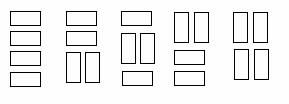HDU 1992Tiling a Grid With Dominoes(状压dp)
Tiling a Grid With Dominoes
Time Limit: 1000/500 MS (Java/Others) Memory Limit: 32768/32768 K (Java/Others)Total Submission(s): 410 Accepted Submission(s): 321
Problem Description
We wish to tile a grid 4 units high and N units long with rectangles (dominoes) 2 units by one unit (in either orientation). For example, the figure shows the five different ways that a grid 4 units high and 2 units wide may be tiled.

Write a program that takes as input the width, W, of the grid and outputs the number of different ways to tile a 4-by-W grid.

Write a program that takes as input the width, W, of the grid and outputs the number of different ways to tile a 4-by-W grid.
Input
The first line of input contains a single integer N, (1 ≤ N ≤ 1000) which is the number of datasets that follow.
Each dataset contains a single decimal integer, the width, W, of the grid for this problem instance.
Each dataset contains a single decimal integer, the width, W, of the grid for this problem instance.
Output
For each problem instance, there is one line of output: The problem instance number as a decimal integer (start counting at one), a single space and the number of tilings of a 4-by-W grid. The values of W will be chosen so the count will fit in a 32-bit integer.
Sample Input
3 2 3 7
Sample Output
1 5 2 11 3 781
Source
2008 “Shun Yu Cup” Zhejiang Collegiate Programming Contest - Warm Up(1)
Recommend
linle | We have carefully selected several similar problems for you: 1988 1993 1985 1986 1987
题目大意:题目意思是有一块4*N(1 ≤ N ≤ 1000)实际上n不会超过21的空地。你只有1*2的砖。问你铺满这块区域有多少种方法。
解题思路:
自己在那里乱搞递推公式,状压dp的思想很不错,博博讲的很精辟。我们算成n行的砖,每行有四。然后用4个01位表示一行,如果是0表示这一行不会占用下一行的地方,如果是1表示会占用下一行的砖。这样想想就比较容易了。状态转移有三种:
1,当前行当前位为1,那么直接转移到下一位。
2,当前行当前位为0,那么可以表示下一行可以为1.
3,当前行当前位和下一位为00,那么下一行也可以为00。
详见AC代码:
题目地址:http://acm.hdu.edu.cn/showproblem.php?pid=1992
博博详解:http://blog.csdn.net/bossup/article/details/21948079
AC代码:
#include<iostream>
#include<cstdio>
#include<cmath>
#include<string>
#include<cstring>
using namespace std;
int dp[1005][16];
void dfs(int r,int c,int cur,int nex)
//分别表示当前行,当前列,当前状态,可转移的状态
{
if(c>3)
{
dp[r+1][nex]+=dp[r][cur];
return;
}
if(!(cur&(1<<c)))
{
dfs(r,c+1,cur,nex|(1<<c)); //竖着放,用1
if(c<=2&&!(cur&(1<<(c+1))))
dfs(r,c+2,cur,nex); //也可以横着放,两个0
}
else
dfs(r,c+1,cur,nex); //位置被上面的占了
}
int main()
{
memset(dp,0,sizeof(dp));
dp[0][0]=1;
int i,j;
for(i=0;i<22;i++) //22已经爆int32了
for(j=0;j<16;j++)
if(dp[i][j])
dfs(i,0,j,0);
int tes,x;
cin>>tes;
for(i=1;i<=tes;i++)
{
cin>>x;
cout<<i<<" "<<dp[x][0]<<endl;
}
return 0;
}